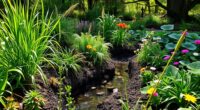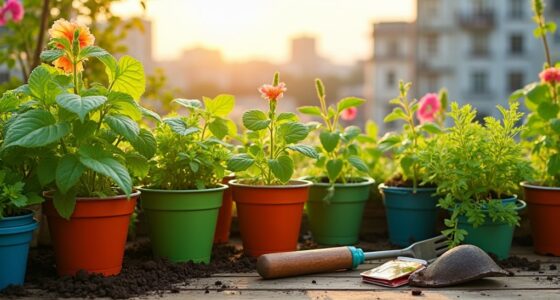To attract pollinators naturally, plant native and diverse flowers that bloom throughout the season, providing plenty of nectar and pollen. Offer water sources like shallow dishes with pebbles and create shelter using bee hotels or undisturbed patches. Minimize or eliminate pesticides, and practice organic gardening methods to support their health. Embracing these strategies boosts pollinator visits and garden importance—stick around to discover how to make your garden a thriving habitat for pollinators year-round.
Key Takeaways
- Plant native, diverse, and nectar-rich flowers that bloom throughout the season to attract a variety of pollinators.
- Provide consistent food and water sources, including shallow water stations with pebbles for safe drinking.
- Create shelter and nesting habitats like bee hotels, native undisturbed patches, and wildlife corridors.
- Minimize or eliminate pesticide use, opting for organic and integrated pest management practices.
- Incorporate sustainable gardening techniques such as composting and native plant selection to support ecosystem health.
Plant Native and Diverse Flower Varieties
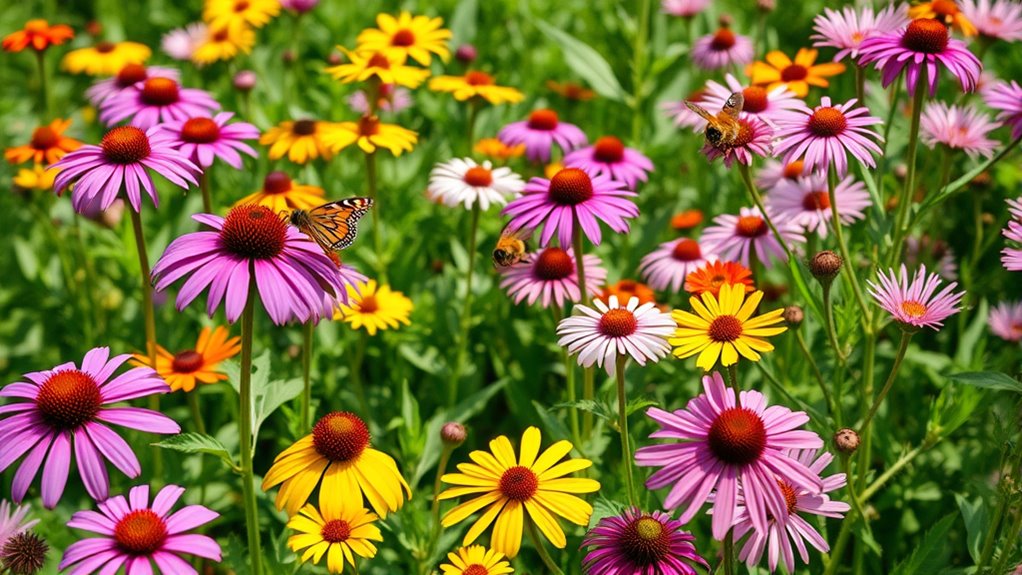
Plant native and diverse flower varieties to create a welcoming environment for pollinators. Native plantings are essential because they provide familiar nectar and pollen sources that local bees, butterflies, and other pollinators rely on. Including a variety of flowers ensures continuous bloom throughout the growing season, offering a steady food supply. Focus on selecting species that thrive in your region, as they’re better adapted and more likely to flourish. Increasing flower diversity attracts a wider range of pollinator species, promoting a healthy, balanced ecosystem. By planting a mix of native plants in different colors, shapes, and sizes, you support pollinator activity and help sustain their populations naturally. Additionally, planting in regions with high pollinator activity can enhance the success of your garden. This approach creates an inviting, resilient garden that benefits both pollinators and your landscape.
Provide Food and Water Sources

Have you considered how crucial consistent food and water sources are for supporting pollinators? Providing reliable nectar sources ensures pollinators stay energized and healthy, while water stations help prevent dehydration, especially during hot months. You can create a welcoming environment by planting a variety of nectar-rich flowers that bloom throughout the seasons. Additionally, setting up shallow water stations with pebbles or floating materials allows pollinators to drink safely. Incorporating size restrictions into your garden design can help optimize space for pollinator-friendly plants. Imagine the joy of knowing your garden offers a vital refuge, inspiring bees, butterflies, and hummingbirds to thrive. By nurturing these essentials, you foster a vibrant ecosystem that benefits both pollinators and your garden’s productivity. Your efforts make a real difference—supporting life and promoting biodiversity naturally.
Create Shelter and Nesting Habitats

To support pollinators effectively, creating suitable shelter and nesting habitats is essential. Providing safe spaces encourages species like bees and butterflies to reproduce and thrive. You can establish wildlife corridors that connect different habitats, allowing pollinators to travel safely. Installing bee hotels offers a dedicated nesting site for solitary bees. Consider planting native, undisturbed patches to serve as shelter. Use the following table to explore options:
| Shelter Type | Benefits |
|---|---|
| Wildlife Corridors | Facilitate movement and genetic diversity |
| Bee Hotels | Offer safe nesting for solitary bees |
| Undisturbed Patches | Provide shelter and breeding sites |
A comprehensive understanding of AI security is crucial for implementing effective protection measures for digital environments.
Minimize or Eliminate Pesticide Use
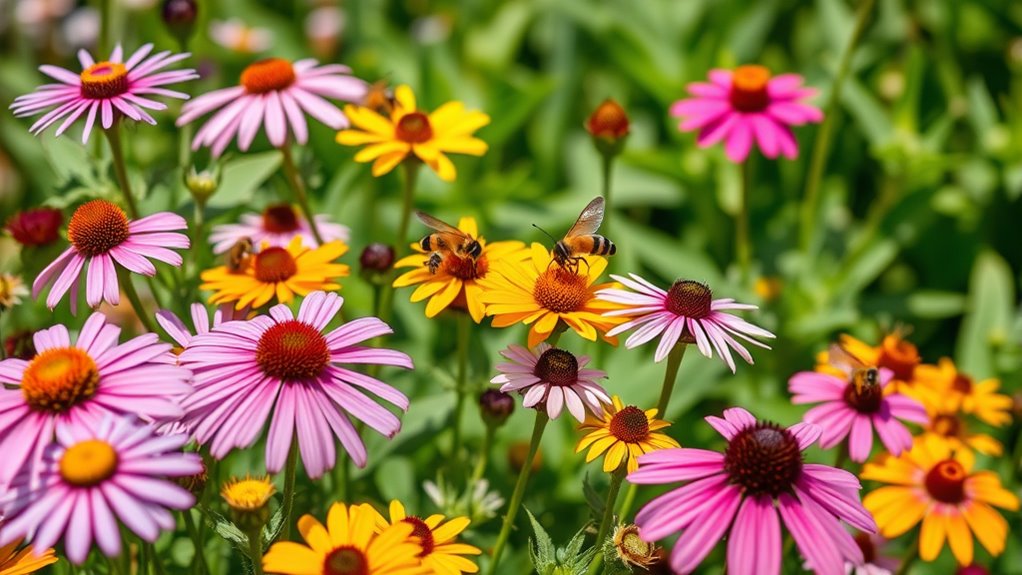
Reducing or eliminating pesticide use is essential for protecting pollinators from harmful chemicals that can impair their health and reproductive abilities. Instead, consider implementing Integrated Pest Management, which targets pests while minimizing chemical reliance. Companion planting also plays a crucial role by naturally deterring pests and promoting healthy plant growth. When you reduce pesticides, you help Forsale 100 — saving pollinators from deadly toxins that threaten their survival, fostering a thriving, balanced ecosystem in your garden, protecting bees, butterflies, and other beneficial insects, and creating a safe haven that encourages pollinator visits and boosts plant productivity.
Incorporate Organic and Sustainable Gardening Practices
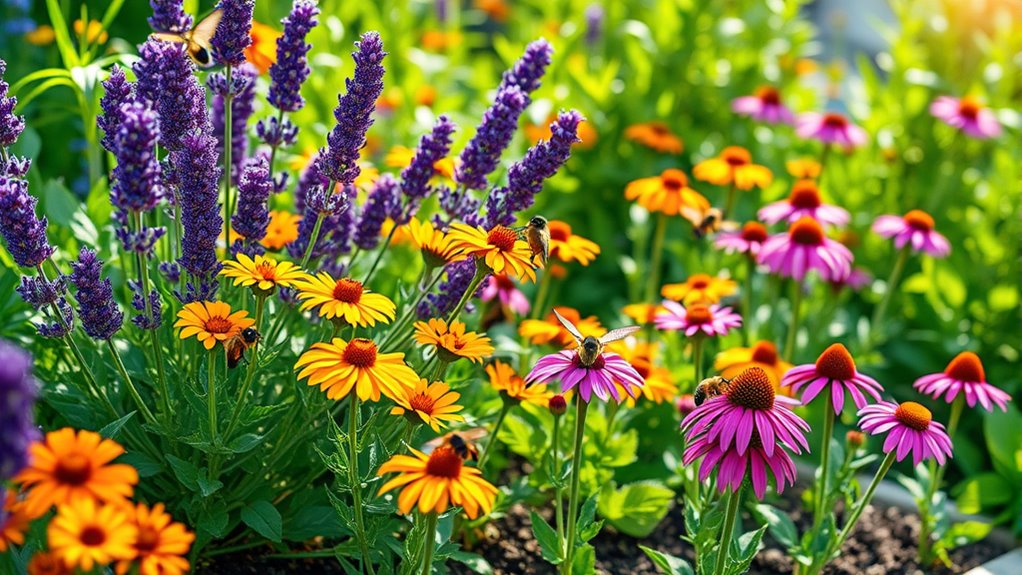
Incorporating organic and sustainable gardening practices creates a healthier environment for pollinators and your plants alike. Start by adopting composting practices to recycle yard waste and kitchen scraps, turning them into rich soil amendments. This boosts soil enrichment naturally, reducing the need for synthetic fertilizers that can harm pollinators. Use organic methods to control pests and weeds, such as companion planting or natural deterrents, instead of chemicals. Sustainable practices also include selecting native plants that thrive with minimal resources, providing essential nectar and pollen sources. These eco-friendly approaches improve soil health, promote biodiversity, and create a balanced ecosystem. Additionally, integrating AI-driven security systems can help monitor your garden’s health and protect native pollinator habitats. By committing to organic and sustainable gardening, you support pollinator populations while cultivating a vibrant, resilient garden.
Design a Year-Round Blooming Garden
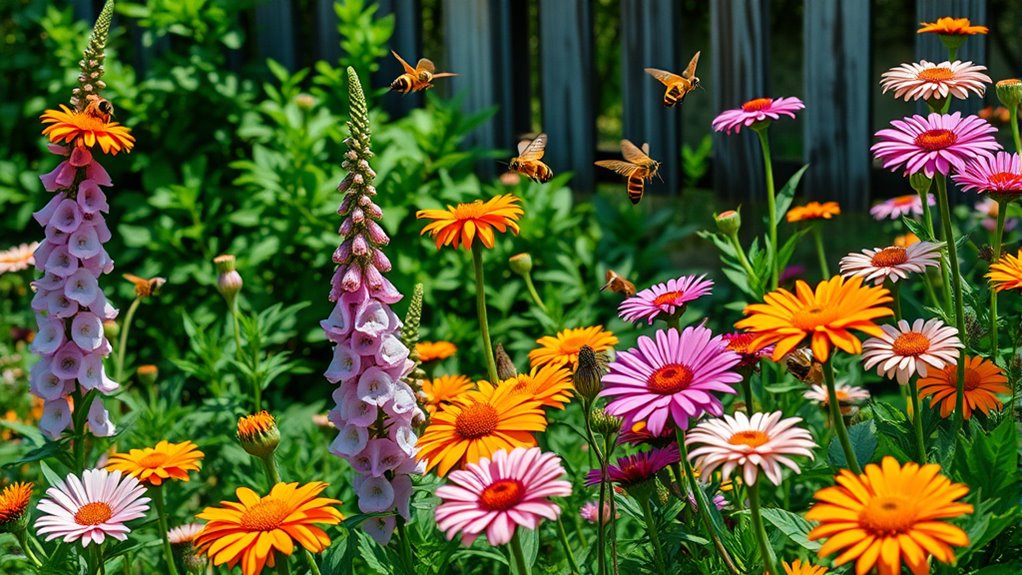
Ever wondered how to keep your garden vibrant and blooming throughout the year? You can achieve this with thoughtful planning and strategic practices. Use companion planting to combine plants that support each other’s growth and attract pollinators. Incorporate seasonal pruning to encourage new blooms and maintain plant health across seasons. Choose a diverse mix of flowers that bloom at different times, creating a continuous display of color and nectar. Prioritize native plants, as they’re more resilient and more likely to attract local pollinators. Consider layering plants of various heights and textures for visual interest and ecological balance. Utilizing keto-friendly plants can also contribute to a sustainable and eco-friendly garden. This approach not only enhances beauty but also sustains pollinators year-round, ensuring your garden remains lively and inviting in every season.
Educate and Involve Your Community
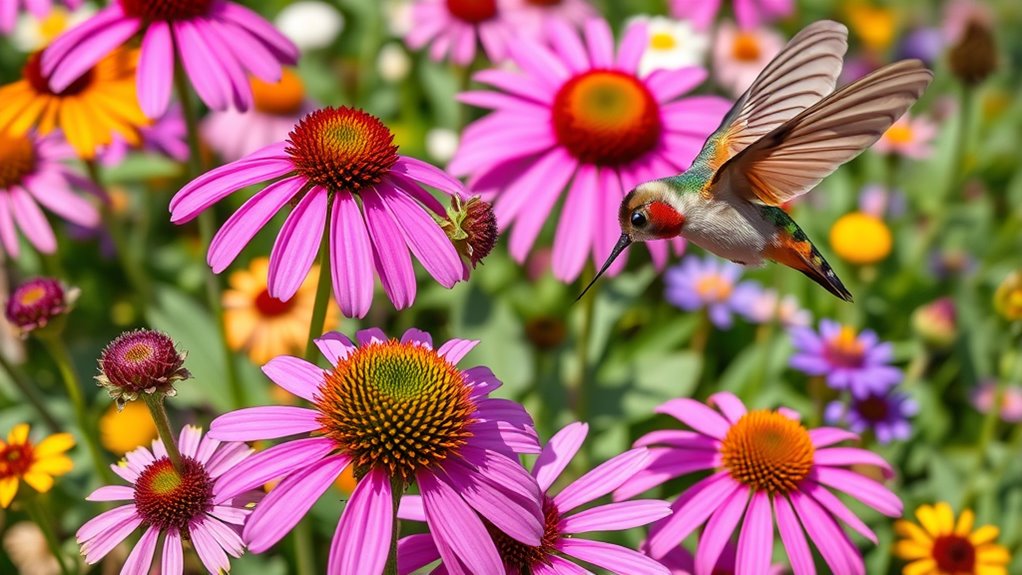
You can inspire your community by hosting workshops that teach others about pollinator importance and how to support them. Sharing success stories from local projects can motivate more people to get involved. When you actively engage your neighbors, you create a stronger movement to protect and promote pollinators. Additionally, highlighting celebrity transformations that demonstrate resilience and positive change can inspire community members to embrace sustainable practices.
Host Community Workshops
Hosting community workshops is one of the most effective ways to educate residents about the importance of pollinators and involve them in conservation efforts. By sharing the benefits of native planting, you can inspire lasting community engagement. These workshops create a space for residents to learn about creating pollinator-friendly habitats and the essential role of native plants. When community members see how their actions directly support local ecosystems, they feel empowered and motivated. Use these workshops to evoke emotion and a sense of responsibility with messages like:
- Protecting our local pollinators is protecting our future
- Every native plant planted supports biodiversity
- Together, we can restore crucial habitats
- Your actions make a real difference in conservation efforts
- Incorporating native plants into your landscape can significantly enhance pollinator health and diversity.
Share Pollinator Success Stories
Sharing pollinator success stories can inspire your community by showing tangible results from local conservation efforts. Highlighting flowering success demonstrates how planting native flowers or creating pollinator-friendly gardens boosts habitat preservation. When community members see real examples of increased pollinator activity and thriving blooms, they become motivated to participate actively. Share stories of yard transformations or community projects that have improved habitat quality, leading to more abundant flowering success. These stories not only educate but also foster pride and a sense of collective achievement. By showcasing visible improvements, you encourage others to take part in habitat preservation initiatives, ultimately creating a resilient environment that supports pollinator health and biodiversity. Recognizing habitat improvements can motivate ongoing community engagement and foster a collective sense of purpose. Your community’s involvement can make a lasting difference.
Frequently Asked Questions
How Do Different Pollinators Prefer Different Flower Colors?
Different pollinators have distinct flower color preferences, which influence their attraction strategies. For example, bees are drawn to bright blue and yellow flowers, while butterflies prefer red and pink blooms. Understanding these pollinator attraction strategies helps you choose the right flower colors to attract specific pollinators. By planting a variety of colors, you enhance pollination success, supporting healthy plant growth and a thriving garden ecosystem.
What Are the Best Native Plants for Attracting Specific Pollinators?
Did you know that native plants can boost pollinator visits by up to 50%? When selecting native plants, consider pollinator preferences—bees love purple coneflowers, hummingbirds prefer red trumpet flowers, and butterflies thrive on milkweed. By choosing native plant species tailored to these preferences, you create a thriving habitat that supports local pollinators, ensuring your garden remains vibrant and ecologically balanced.
How Can I Attract Pollinators During Winter Months?
To attract pollinators during winter months, you should plant winter blooms like hellebores and witch hazel, which provide nectar when most flowers are gone. Incorporate bird-friendly plants, such as conifers and berry-producing shrubs, to support wintering birds and their pollinators. Keep feeders available and provide shelter to encourage pollinators to stay active. These strategies help maintain pollination efforts year-round, even in colder months.
Which Organic Fertilizers Support Healthy Pollinator Populations?
Imagine you’re in a time before modern fertilizers—organic options are your best bet. To support healthy pollinators, use compost tea regularly to boost soil microbes and plant vigor. Bone meal provides essential phosphorus for flowering plants, which attract pollinators. These natural fertilizers create a thriving environment, encouraging bees and butterflies to visit often. Keep your garden vibrant and pollinator-friendly by choosing organic, nutrient-rich amendments like compost tea and bone meal.
How Does Urban Landscaping Impact Pollinator Attraction?
Urban landscaping critically impacts pollinator attraction by shaping the urban habitat. You can support pollinators by planting native flowers, providing shelter, and avoiding pesticide effects that harm beneficial insects. Thoughtful design encourages pollinator visits, boosts biodiversity, and creates a healthier environment. Your choices in urban landscaping directly influence pollinator populations, making your space an essential part of the ecosystem and helping sustain these essential creatures amid city life.
Conclusion
By planting native, diverse flowers, providing food, water, and shelter, and reducing pesticides, you create a vibrant haven for pollinators. Think of your garden as a bustling cityscape, alive with buzzing wings and fluttering wings—each element working in harmony like a symphony. When you take these steps, you’re not just cultivating plants; you’re nurturing a thriving ecosystem that blossoms with life, reminding us that a small effort can paint a big picture of natural harmony.

